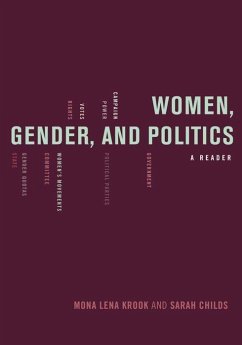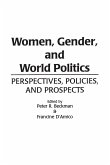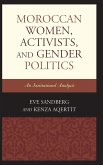Women, Gender, and Politics
A Reader
Herausgeber: Krook, Mona Lena; Childs, Sarah
Women, Gender, and Politics
A Reader
Herausgeber: Krook, Mona Lena; Childs, Sarah
- Gebundenes Buch
- Merkliste
- Auf die Merkliste
- Bewerten Bewerten
- Teilen
- Produkt teilen
- Produkterinnerung
- Produkterinnerung
Women, Gender, and Politics brings together both classic and recent readings on central topics in the study of gender and politics, and places an emphasis on comparing developed and developing countries. Genuinely international in its focus, the book is divided into six sections to reflect the range of research in the subfield: (1) women and social movements, (2) women and political parties, (3) women, gender, and elections, (4) women, gender, and political representation, (5) women, gender, and social policies, and (6) women, gender, and the state. Each section serves as an introduction to…mehr
Andere Kunden interessierten sich auch für
![Women, Gender, and World Politics Women, Gender, and World Politics]() Women, Gender, and World Politics47,99 €
Women, Gender, and World Politics47,99 €![Women, Gender, and Rebel Governance during Civil Wars Women, Gender, and Rebel Governance during Civil Wars]() Meredith Maloof LokenWomen, Gender, and Rebel Governance during Civil Wars60,99 €
Meredith Maloof LokenWomen, Gender, and Rebel Governance during Civil Wars60,99 €![Women, Gender, and Terrorism Women, Gender, and Terrorism]() Women, Gender, and Terrorism28,99 €
Women, Gender, and Terrorism28,99 €![Women, Gender, and Terrorism Women, Gender, and Terrorism]() Women, Gender, and Terrorism73,99 €
Women, Gender, and Terrorism73,99 €![Moroccan Women, Activists, and Gender Politics Moroccan Women, Activists, and Gender Politics]() Eve SandbergMoroccan Women, Activists, and Gender Politics123,99 €
Eve SandbergMoroccan Women, Activists, and Gender Politics123,99 €![Women, Unionism and Loyalism in Northern Ireland Women, Unionism and Loyalism in Northern Ireland]() Rachel WardWomen, Unionism and Loyalism in Northern Ireland67,99 €
Rachel WardWomen, Unionism and Loyalism in Northern Ireland67,99 €![Women, Gender and Religious Nationalism Women, Gender and Religious Nationalism]() Women, Gender and Religious Nationalism118,99 €
Women, Gender and Religious Nationalism118,99 €-
-
-
Women, Gender, and Politics brings together both classic and recent readings on central topics in the study of gender and politics, and places an emphasis on comparing developed and developing countries. Genuinely international in its focus, the book is divided into six sections to reflect the range of research in the subfield: (1) women and social movements, (2) women and political parties, (3) women, gender, and elections, (4) women, gender, and political representation, (5) women, gender, and social policies, and (6) women, gender, and the state. Each section serves as an introduction to general trends in thinking about women and politics, and the readings capture the ways that research has developed both thematically and chronologically in all of the six broad areas. The volume's innovative design, global approach, and comprehensive coverage make it an ideal teaching book and a valuable resource for students and scholars throughout the world.
Hinweis: Dieser Artikel kann nur an eine deutsche Lieferadresse ausgeliefert werden.
Hinweis: Dieser Artikel kann nur an eine deutsche Lieferadresse ausgeliefert werden.
Produktdetails
- Produktdetails
- Verlag: Hurst & Co.
- Seitenzahl: 384
- Erscheinungstermin: 1. März 2010
- Englisch
- Abmessung: 254mm x 178mm x 22mm
- Gewicht: 862g
- ISBN-13: 9780195368802
- ISBN-10: 0195368800
- Artikelnr.: 27209016
- Herstellerkennzeichnung
- Libri GmbH
- Europaallee 1
- 36244 Bad Hersfeld
- gpsr@libri.de
- Verlag: Hurst & Co.
- Seitenzahl: 384
- Erscheinungstermin: 1. März 2010
- Englisch
- Abmessung: 254mm x 178mm x 22mm
- Gewicht: 862g
- ISBN-13: 9780195368802
- ISBN-10: 0195368800
- Artikelnr.: 27209016
- Herstellerkennzeichnung
- Libri GmbH
- Europaallee 1
- 36244 Bad Hersfeld
- gpsr@libri.de
Mona Krook is Assistant Professor of Political Science at Washington University. Sarah Childs is Senior Lecturer in Politics at the University of Bristol.
* PREFACE
* 1.: Krook, Mona Lena and Sarah Childs. "Women, Gender, and Politics:
An Introduction."
* Part I WOMEN AND SOCIAL MOVEMENTS
* 2.: Molyneux, Maxine. 1985. "Mobilization Without Emancipation?
Women's Interests, the State and Revolution in Nicaragua." Feminist
Studies 11, no. 2: 227-254.
* 3.: Beckwith, Karen. 2000. "Beyond Compare? Women's Movements in
Comparative Perspective." European Journal of Political Research 37,
no. 4: 431-468.
* 4.: Baldez, Lisa. 2003. "Women's Movements and Democratic Transition
in Chile, Brazil, East Germany, and Poland." Comparative Politics 35,
no. 3: 253-272.
* 5.: Katzenstein, Mary Fainsod. 1998. "Protest Moves inside
Institutions." Pp. 3-22 in Faithful and Fearless: Moving Feminist
Protest inside the Church and Military. Princeton: Princeton
University Press.
* 6.: Strolovitch, Dara Z. 2006. "Do Interest Groups Represent the
Disadvantaged? Advocacy at the Intersections of Race, Class, and
Gender." Journal of Politics 68, no. 4: 894-910.
* 7.: Alvarez, Sonia E. 2000. "Translating the Global: Effects of
Transnational Organizing on Latin American Feminist Discourses and
Practices." Meridians: A Journal of Feminisms, Race, Transnationalism
1, no. 1: 29-67.
* 8.: Cunningham, Karla J. 2003. "Cross-Regional Trends in Female
Terrorism." Studies in Conflict and Terrorism 26, no. 3: 171-195.
* WOMEN AND POLITICAL PARTIES
* 9.: Lovenduski, Joni. 1993. "Introduction: The Dynamics of Gender and
Party." Pp. 1-15 in Gender and Party Politics, ed. Joni Lovenduski
and Pippa Norris. Thousand Oaks: Sage.
* 10.: Young, Lisa. 2000. "Theorizing Feminist Strategy and Party
Responsiveness." Pp. 11-26 in Feminists and Party Politics.
Vancouver: UBC Press.
* 11.: Freeman, Jo. 2000. "Building a Base: Women in Local Party
Politics." Pp. 149-178 in A Room at a Time: How Women Entered Party
Politics. Lanham: Rowman and Littlefield.
* 12.: Sainsbury, Diane. 2004. "Women's Political Representation in
Sweden: Discursive Politics and Institutional Presence." Scandinavian
Political Studies 27, no. 1: 65-87.
* 13.: Goetz, Anne Marie. 2003. "The Problem with Patronage:
Constraints on Women's Political Effectiveness in Uganda." Pp.
110-139 in No Shortcuts to Power: African Women in Politics and
Policy-Making, ed. Anne Marie Goetz and Shireen Hassim. New York:
Zed.
* 14.: Dominelli, Lena and Gudrun Jonsdottir. 1988. "Feminist Political
Organization in Iceland: Some Reflections on the Experience of Kwenna
Frambothid." Feminist Studies 30: 36-60.
* WOMEN, GENDER, AND ELECTIONS
* 15.: Inglehart, Ronald and Pippa Norris. 2000. "The Developmental
Theory of the Gender Gap: Women's and Men's Voting Behavior in Global
Perspective." International Political Science Review 21, no. 4:
441-463.
* 16.: Norris, Pippa and Joni Lovenduski. 1995. "Puzzles in Political
Recruitment." Pp. 1-19 in Political Recruitment: Gender, Race, and
Class in the British Parliament. New York: Cambridge University
Press.
* 17.: Fox, Richard L. and Jennifer L. Lawless. 2004. "Entering the
Arena? Gender and the Decision to Run for Office." American Journal
of Political Science 48, no. 2: 264-280.
* 18.: Niven, David. 1998. "Party Elites and Women Candidates: The
Shape of Bias." Women and Politics 19, no. 2: 57-80.
* 19.: Caul, Miki. 1999. "Women's Representation in Parliament: The
Role of Political Parties." Party Politics 5, no. 1: 79-98.
* 20.: Yoon, Mi Yung. 2004. "Explaining Women's Legislative
Representation in Sub-Saharan Africa." Legislative Studies Quarterly
29, no. 3: 447-466.
* 21.: Dahlerup, Drude and Lenita Freidenvall. 2005. "Quotas as a 'Fast
Track' to Equal Representation for Women: Why Scandinavia is No
Longer the Model." International Feminist Journal of Politics 7, no.
1: 26-48.
* WOMEN, GENDER, AND POLITICAL REPRESENTATION
* 22.: Phillips, Anne. 1995. "Quotas for Women." Pp. 57-83 in The
Politics of Presence: The Political Representation of Gender,
Ethnicity, and Race. New York: Oxford University Press.
* 23.: Young, Iris Marion. 2000. "Representation and Social
Perspective." Pp. 121-153 in Inclusion and Democracy. New York:
Oxford University Press.
* 24.: Mansbridge, Jane. 1999. "Should Blacks Represent Blacks and
Women Represent Women? A Contingent 'Yes.'" Journal of Politics 61,
no. 3: 628-657.
* 25.: Dovi, Suzanne. 2002. "Preferable Descriptive Representatives:
Will Just Any Woman, Black, or Latino Do?" American Political Science
Review 96, no. 4: 729-743.
* 26.: Dahlerup, Drude. 1988. "From a Small to a Large Minority: Women
in Scandinavian Politics." Scandinavian Political Studies 11, no.4:
275-297.
* 27.: Weldon, S. Laurel. 2002. "Beyond Bodies: Institutional Sources
of Representation for Women in Democratic Policymaking." Journal of
Politics 64, no. 4: 1153-1174.
* WOMEN, GENDER, AND PUBLIC POLICIES
* 28.: Tamerius, Karin L. 1995. "Sex, Gender, and Leadership in the
Representation of Women." Pp. 93-112 in Gender Power, Leadership, and
Governance, ed. Georgia Duerst-Lahti and Rita Mae Kelly. Ann Arbor:
University of Michigan Press.
* 29.: Hawkesworth, Mary. 2003. "Congressional Enactments of
Race-Gender: Toward a Theory of Raced-Gendered Institutions."
American Political Science Review 97, no. 4: 529-550.
* 30.: Bacchi, Carol Lee. 1999. "Taking Problems Apart." Pp. 1-13 in
Women, Policy, and Politics. Thousand Oaks: Sage.
* 31.: Htun, Mala. 2003. "Sex and the State in Latin America." Pp. 1-28
in Sex and the State: Abortion, Divorce, and the Family Under Latin
American Dictatorships and Democracies. New York: Cambridge
University Press.
* 32.: Sarvasy, Wendy. 1992. "Beyond the Difference versus Equality
Policy Debate: Postsuffrage Feminism, Citizenship, and the Quest for
a Feminist Welfare State." Signs 17, no. 2: 329-362.
* 33.: Squires, Judith. 2005. "Is Mainstreaming Transformative?
Theorizing Mainstreaming in the Context of Diversity and
Deliberation." Social Politics 12, no. 3: 366-388.
* WOMEN, GENDER, AND THE STATE
* 34.: MacKinnon, Catharine A. 1989. "The Liberal State." Pp. 157-170
in Toward a Feminist Theory of the State. Cambridge: Harvard
University Press.
* 35.: Kantola, Johanna. 2006. "Gender and the State: Theories and
Debates." In Feminists Theorize the State. New York: Palgrave.
* 36.: Orloff, Ann. 1996. "Gender in the Welfare State." Annual Review
of Sociology 22: 51-78.
* 37.: Chappell, Louise. 2000. "Interacting With the State: Feminist
Strategies and Political Opportunities." International Feminist
Journal of Politics 2, no. 2: 244-275.
* 38.: Stetson, Dorothy McBride and Amy Mazur. 1995. "Introduction."
Pp. 1-21 in Comparative State Feminism, ed. Dorothy McBride Stetson
and Amy Mazu. Thousand Oaks: Sage.
* 39.: Threlfall, Monica. 1998. "State Feminism or Party Feminism?
Feminist Politics and the Spanish Institute for Women." European
Journal of Women's Studies 5: 69-93.
* 40.: Banaszak, Lee Ann, Karen Beckwith, and Dieter Rucht. 2003. "When
Power Relocates: Interactive Changes in Women's Movements and
States." Pp. 1-29 in Women's Movements Facing the Reconfigured State,
ed. Lee Ann Banaszak, Karen Beckwith, and Dieter Rucht. New York:
Cambridge University Press.
* 1.: Krook, Mona Lena and Sarah Childs. "Women, Gender, and Politics:
An Introduction."
* Part I WOMEN AND SOCIAL MOVEMENTS
* 2.: Molyneux, Maxine. 1985. "Mobilization Without Emancipation?
Women's Interests, the State and Revolution in Nicaragua." Feminist
Studies 11, no. 2: 227-254.
* 3.: Beckwith, Karen. 2000. "Beyond Compare? Women's Movements in
Comparative Perspective." European Journal of Political Research 37,
no. 4: 431-468.
* 4.: Baldez, Lisa. 2003. "Women's Movements and Democratic Transition
in Chile, Brazil, East Germany, and Poland." Comparative Politics 35,
no. 3: 253-272.
* 5.: Katzenstein, Mary Fainsod. 1998. "Protest Moves inside
Institutions." Pp. 3-22 in Faithful and Fearless: Moving Feminist
Protest inside the Church and Military. Princeton: Princeton
University Press.
* 6.: Strolovitch, Dara Z. 2006. "Do Interest Groups Represent the
Disadvantaged? Advocacy at the Intersections of Race, Class, and
Gender." Journal of Politics 68, no. 4: 894-910.
* 7.: Alvarez, Sonia E. 2000. "Translating the Global: Effects of
Transnational Organizing on Latin American Feminist Discourses and
Practices." Meridians: A Journal of Feminisms, Race, Transnationalism
1, no. 1: 29-67.
* 8.: Cunningham, Karla J. 2003. "Cross-Regional Trends in Female
Terrorism." Studies in Conflict and Terrorism 26, no. 3: 171-195.
* WOMEN AND POLITICAL PARTIES
* 9.: Lovenduski, Joni. 1993. "Introduction: The Dynamics of Gender and
Party." Pp. 1-15 in Gender and Party Politics, ed. Joni Lovenduski
and Pippa Norris. Thousand Oaks: Sage.
* 10.: Young, Lisa. 2000. "Theorizing Feminist Strategy and Party
Responsiveness." Pp. 11-26 in Feminists and Party Politics.
Vancouver: UBC Press.
* 11.: Freeman, Jo. 2000. "Building a Base: Women in Local Party
Politics." Pp. 149-178 in A Room at a Time: How Women Entered Party
Politics. Lanham: Rowman and Littlefield.
* 12.: Sainsbury, Diane. 2004. "Women's Political Representation in
Sweden: Discursive Politics and Institutional Presence." Scandinavian
Political Studies 27, no. 1: 65-87.
* 13.: Goetz, Anne Marie. 2003. "The Problem with Patronage:
Constraints on Women's Political Effectiveness in Uganda." Pp.
110-139 in No Shortcuts to Power: African Women in Politics and
Policy-Making, ed. Anne Marie Goetz and Shireen Hassim. New York:
Zed.
* 14.: Dominelli, Lena and Gudrun Jonsdottir. 1988. "Feminist Political
Organization in Iceland: Some Reflections on the Experience of Kwenna
Frambothid." Feminist Studies 30: 36-60.
* WOMEN, GENDER, AND ELECTIONS
* 15.: Inglehart, Ronald and Pippa Norris. 2000. "The Developmental
Theory of the Gender Gap: Women's and Men's Voting Behavior in Global
Perspective." International Political Science Review 21, no. 4:
441-463.
* 16.: Norris, Pippa and Joni Lovenduski. 1995. "Puzzles in Political
Recruitment." Pp. 1-19 in Political Recruitment: Gender, Race, and
Class in the British Parliament. New York: Cambridge University
Press.
* 17.: Fox, Richard L. and Jennifer L. Lawless. 2004. "Entering the
Arena? Gender and the Decision to Run for Office." American Journal
of Political Science 48, no. 2: 264-280.
* 18.: Niven, David. 1998. "Party Elites and Women Candidates: The
Shape of Bias." Women and Politics 19, no. 2: 57-80.
* 19.: Caul, Miki. 1999. "Women's Representation in Parliament: The
Role of Political Parties." Party Politics 5, no. 1: 79-98.
* 20.: Yoon, Mi Yung. 2004. "Explaining Women's Legislative
Representation in Sub-Saharan Africa." Legislative Studies Quarterly
29, no. 3: 447-466.
* 21.: Dahlerup, Drude and Lenita Freidenvall. 2005. "Quotas as a 'Fast
Track' to Equal Representation for Women: Why Scandinavia is No
Longer the Model." International Feminist Journal of Politics 7, no.
1: 26-48.
* WOMEN, GENDER, AND POLITICAL REPRESENTATION
* 22.: Phillips, Anne. 1995. "Quotas for Women." Pp. 57-83 in The
Politics of Presence: The Political Representation of Gender,
Ethnicity, and Race. New York: Oxford University Press.
* 23.: Young, Iris Marion. 2000. "Representation and Social
Perspective." Pp. 121-153 in Inclusion and Democracy. New York:
Oxford University Press.
* 24.: Mansbridge, Jane. 1999. "Should Blacks Represent Blacks and
Women Represent Women? A Contingent 'Yes.'" Journal of Politics 61,
no. 3: 628-657.
* 25.: Dovi, Suzanne. 2002. "Preferable Descriptive Representatives:
Will Just Any Woman, Black, or Latino Do?" American Political Science
Review 96, no. 4: 729-743.
* 26.: Dahlerup, Drude. 1988. "From a Small to a Large Minority: Women
in Scandinavian Politics." Scandinavian Political Studies 11, no.4:
275-297.
* 27.: Weldon, S. Laurel. 2002. "Beyond Bodies: Institutional Sources
of Representation for Women in Democratic Policymaking." Journal of
Politics 64, no. 4: 1153-1174.
* WOMEN, GENDER, AND PUBLIC POLICIES
* 28.: Tamerius, Karin L. 1995. "Sex, Gender, and Leadership in the
Representation of Women." Pp. 93-112 in Gender Power, Leadership, and
Governance, ed. Georgia Duerst-Lahti and Rita Mae Kelly. Ann Arbor:
University of Michigan Press.
* 29.: Hawkesworth, Mary. 2003. "Congressional Enactments of
Race-Gender: Toward a Theory of Raced-Gendered Institutions."
American Political Science Review 97, no. 4: 529-550.
* 30.: Bacchi, Carol Lee. 1999. "Taking Problems Apart." Pp. 1-13 in
Women, Policy, and Politics. Thousand Oaks: Sage.
* 31.: Htun, Mala. 2003. "Sex and the State in Latin America." Pp. 1-28
in Sex and the State: Abortion, Divorce, and the Family Under Latin
American Dictatorships and Democracies. New York: Cambridge
University Press.
* 32.: Sarvasy, Wendy. 1992. "Beyond the Difference versus Equality
Policy Debate: Postsuffrage Feminism, Citizenship, and the Quest for
a Feminist Welfare State." Signs 17, no. 2: 329-362.
* 33.: Squires, Judith. 2005. "Is Mainstreaming Transformative?
Theorizing Mainstreaming in the Context of Diversity and
Deliberation." Social Politics 12, no. 3: 366-388.
* WOMEN, GENDER, AND THE STATE
* 34.: MacKinnon, Catharine A. 1989. "The Liberal State." Pp. 157-170
in Toward a Feminist Theory of the State. Cambridge: Harvard
University Press.
* 35.: Kantola, Johanna. 2006. "Gender and the State: Theories and
Debates." In Feminists Theorize the State. New York: Palgrave.
* 36.: Orloff, Ann. 1996. "Gender in the Welfare State." Annual Review
of Sociology 22: 51-78.
* 37.: Chappell, Louise. 2000. "Interacting With the State: Feminist
Strategies and Political Opportunities." International Feminist
Journal of Politics 2, no. 2: 244-275.
* 38.: Stetson, Dorothy McBride and Amy Mazur. 1995. "Introduction."
Pp. 1-21 in Comparative State Feminism, ed. Dorothy McBride Stetson
and Amy Mazu. Thousand Oaks: Sage.
* 39.: Threlfall, Monica. 1998. "State Feminism or Party Feminism?
Feminist Politics and the Spanish Institute for Women." European
Journal of Women's Studies 5: 69-93.
* 40.: Banaszak, Lee Ann, Karen Beckwith, and Dieter Rucht. 2003. "When
Power Relocates: Interactive Changes in Women's Movements and
States." Pp. 1-29 in Women's Movements Facing the Reconfigured State,
ed. Lee Ann Banaszak, Karen Beckwith, and Dieter Rucht. New York:
Cambridge University Press.
* PREFACE
* 1.: Krook, Mona Lena and Sarah Childs. "Women, Gender, and Politics:
An Introduction."
* Part I WOMEN AND SOCIAL MOVEMENTS
* 2.: Molyneux, Maxine. 1985. "Mobilization Without Emancipation?
Women's Interests, the State and Revolution in Nicaragua." Feminist
Studies 11, no. 2: 227-254.
* 3.: Beckwith, Karen. 2000. "Beyond Compare? Women's Movements in
Comparative Perspective." European Journal of Political Research 37,
no. 4: 431-468.
* 4.: Baldez, Lisa. 2003. "Women's Movements and Democratic Transition
in Chile, Brazil, East Germany, and Poland." Comparative Politics 35,
no. 3: 253-272.
* 5.: Katzenstein, Mary Fainsod. 1998. "Protest Moves inside
Institutions." Pp. 3-22 in Faithful and Fearless: Moving Feminist
Protest inside the Church and Military. Princeton: Princeton
University Press.
* 6.: Strolovitch, Dara Z. 2006. "Do Interest Groups Represent the
Disadvantaged? Advocacy at the Intersections of Race, Class, and
Gender." Journal of Politics 68, no. 4: 894-910.
* 7.: Alvarez, Sonia E. 2000. "Translating the Global: Effects of
Transnational Organizing on Latin American Feminist Discourses and
Practices." Meridians: A Journal of Feminisms, Race, Transnationalism
1, no. 1: 29-67.
* 8.: Cunningham, Karla J. 2003. "Cross-Regional Trends in Female
Terrorism." Studies in Conflict and Terrorism 26, no. 3: 171-195.
* WOMEN AND POLITICAL PARTIES
* 9.: Lovenduski, Joni. 1993. "Introduction: The Dynamics of Gender and
Party." Pp. 1-15 in Gender and Party Politics, ed. Joni Lovenduski
and Pippa Norris. Thousand Oaks: Sage.
* 10.: Young, Lisa. 2000. "Theorizing Feminist Strategy and Party
Responsiveness." Pp. 11-26 in Feminists and Party Politics.
Vancouver: UBC Press.
* 11.: Freeman, Jo. 2000. "Building a Base: Women in Local Party
Politics." Pp. 149-178 in A Room at a Time: How Women Entered Party
Politics. Lanham: Rowman and Littlefield.
* 12.: Sainsbury, Diane. 2004. "Women's Political Representation in
Sweden: Discursive Politics and Institutional Presence." Scandinavian
Political Studies 27, no. 1: 65-87.
* 13.: Goetz, Anne Marie. 2003. "The Problem with Patronage:
Constraints on Women's Political Effectiveness in Uganda." Pp.
110-139 in No Shortcuts to Power: African Women in Politics and
Policy-Making, ed. Anne Marie Goetz and Shireen Hassim. New York:
Zed.
* 14.: Dominelli, Lena and Gudrun Jonsdottir. 1988. "Feminist Political
Organization in Iceland: Some Reflections on the Experience of Kwenna
Frambothid." Feminist Studies 30: 36-60.
* WOMEN, GENDER, AND ELECTIONS
* 15.: Inglehart, Ronald and Pippa Norris. 2000. "The Developmental
Theory of the Gender Gap: Women's and Men's Voting Behavior in Global
Perspective." International Political Science Review 21, no. 4:
441-463.
* 16.: Norris, Pippa and Joni Lovenduski. 1995. "Puzzles in Political
Recruitment." Pp. 1-19 in Political Recruitment: Gender, Race, and
Class in the British Parliament. New York: Cambridge University
Press.
* 17.: Fox, Richard L. and Jennifer L. Lawless. 2004. "Entering the
Arena? Gender and the Decision to Run for Office." American Journal
of Political Science 48, no. 2: 264-280.
* 18.: Niven, David. 1998. "Party Elites and Women Candidates: The
Shape of Bias." Women and Politics 19, no. 2: 57-80.
* 19.: Caul, Miki. 1999. "Women's Representation in Parliament: The
Role of Political Parties." Party Politics 5, no. 1: 79-98.
* 20.: Yoon, Mi Yung. 2004. "Explaining Women's Legislative
Representation in Sub-Saharan Africa." Legislative Studies Quarterly
29, no. 3: 447-466.
* 21.: Dahlerup, Drude and Lenita Freidenvall. 2005. "Quotas as a 'Fast
Track' to Equal Representation for Women: Why Scandinavia is No
Longer the Model." International Feminist Journal of Politics 7, no.
1: 26-48.
* WOMEN, GENDER, AND POLITICAL REPRESENTATION
* 22.: Phillips, Anne. 1995. "Quotas for Women." Pp. 57-83 in The
Politics of Presence: The Political Representation of Gender,
Ethnicity, and Race. New York: Oxford University Press.
* 23.: Young, Iris Marion. 2000. "Representation and Social
Perspective." Pp. 121-153 in Inclusion and Democracy. New York:
Oxford University Press.
* 24.: Mansbridge, Jane. 1999. "Should Blacks Represent Blacks and
Women Represent Women? A Contingent 'Yes.'" Journal of Politics 61,
no. 3: 628-657.
* 25.: Dovi, Suzanne. 2002. "Preferable Descriptive Representatives:
Will Just Any Woman, Black, or Latino Do?" American Political Science
Review 96, no. 4: 729-743.
* 26.: Dahlerup, Drude. 1988. "From a Small to a Large Minority: Women
in Scandinavian Politics." Scandinavian Political Studies 11, no.4:
275-297.
* 27.: Weldon, S. Laurel. 2002. "Beyond Bodies: Institutional Sources
of Representation for Women in Democratic Policymaking." Journal of
Politics 64, no. 4: 1153-1174.
* WOMEN, GENDER, AND PUBLIC POLICIES
* 28.: Tamerius, Karin L. 1995. "Sex, Gender, and Leadership in the
Representation of Women." Pp. 93-112 in Gender Power, Leadership, and
Governance, ed. Georgia Duerst-Lahti and Rita Mae Kelly. Ann Arbor:
University of Michigan Press.
* 29.: Hawkesworth, Mary. 2003. "Congressional Enactments of
Race-Gender: Toward a Theory of Raced-Gendered Institutions."
American Political Science Review 97, no. 4: 529-550.
* 30.: Bacchi, Carol Lee. 1999. "Taking Problems Apart." Pp. 1-13 in
Women, Policy, and Politics. Thousand Oaks: Sage.
* 31.: Htun, Mala. 2003. "Sex and the State in Latin America." Pp. 1-28
in Sex and the State: Abortion, Divorce, and the Family Under Latin
American Dictatorships and Democracies. New York: Cambridge
University Press.
* 32.: Sarvasy, Wendy. 1992. "Beyond the Difference versus Equality
Policy Debate: Postsuffrage Feminism, Citizenship, and the Quest for
a Feminist Welfare State." Signs 17, no. 2: 329-362.
* 33.: Squires, Judith. 2005. "Is Mainstreaming Transformative?
Theorizing Mainstreaming in the Context of Diversity and
Deliberation." Social Politics 12, no. 3: 366-388.
* WOMEN, GENDER, AND THE STATE
* 34.: MacKinnon, Catharine A. 1989. "The Liberal State." Pp. 157-170
in Toward a Feminist Theory of the State. Cambridge: Harvard
University Press.
* 35.: Kantola, Johanna. 2006. "Gender and the State: Theories and
Debates." In Feminists Theorize the State. New York: Palgrave.
* 36.: Orloff, Ann. 1996. "Gender in the Welfare State." Annual Review
of Sociology 22: 51-78.
* 37.: Chappell, Louise. 2000. "Interacting With the State: Feminist
Strategies and Political Opportunities." International Feminist
Journal of Politics 2, no. 2: 244-275.
* 38.: Stetson, Dorothy McBride and Amy Mazur. 1995. "Introduction."
Pp. 1-21 in Comparative State Feminism, ed. Dorothy McBride Stetson
and Amy Mazu. Thousand Oaks: Sage.
* 39.: Threlfall, Monica. 1998. "State Feminism or Party Feminism?
Feminist Politics and the Spanish Institute for Women." European
Journal of Women's Studies 5: 69-93.
* 40.: Banaszak, Lee Ann, Karen Beckwith, and Dieter Rucht. 2003. "When
Power Relocates: Interactive Changes in Women's Movements and
States." Pp. 1-29 in Women's Movements Facing the Reconfigured State,
ed. Lee Ann Banaszak, Karen Beckwith, and Dieter Rucht. New York:
Cambridge University Press.
* 1.: Krook, Mona Lena and Sarah Childs. "Women, Gender, and Politics:
An Introduction."
* Part I WOMEN AND SOCIAL MOVEMENTS
* 2.: Molyneux, Maxine. 1985. "Mobilization Without Emancipation?
Women's Interests, the State and Revolution in Nicaragua." Feminist
Studies 11, no. 2: 227-254.
* 3.: Beckwith, Karen. 2000. "Beyond Compare? Women's Movements in
Comparative Perspective." European Journal of Political Research 37,
no. 4: 431-468.
* 4.: Baldez, Lisa. 2003. "Women's Movements and Democratic Transition
in Chile, Brazil, East Germany, and Poland." Comparative Politics 35,
no. 3: 253-272.
* 5.: Katzenstein, Mary Fainsod. 1998. "Protest Moves inside
Institutions." Pp. 3-22 in Faithful and Fearless: Moving Feminist
Protest inside the Church and Military. Princeton: Princeton
University Press.
* 6.: Strolovitch, Dara Z. 2006. "Do Interest Groups Represent the
Disadvantaged? Advocacy at the Intersections of Race, Class, and
Gender." Journal of Politics 68, no. 4: 894-910.
* 7.: Alvarez, Sonia E. 2000. "Translating the Global: Effects of
Transnational Organizing on Latin American Feminist Discourses and
Practices." Meridians: A Journal of Feminisms, Race, Transnationalism
1, no. 1: 29-67.
* 8.: Cunningham, Karla J. 2003. "Cross-Regional Trends in Female
Terrorism." Studies in Conflict and Terrorism 26, no. 3: 171-195.
* WOMEN AND POLITICAL PARTIES
* 9.: Lovenduski, Joni. 1993. "Introduction: The Dynamics of Gender and
Party." Pp. 1-15 in Gender and Party Politics, ed. Joni Lovenduski
and Pippa Norris. Thousand Oaks: Sage.
* 10.: Young, Lisa. 2000. "Theorizing Feminist Strategy and Party
Responsiveness." Pp. 11-26 in Feminists and Party Politics.
Vancouver: UBC Press.
* 11.: Freeman, Jo. 2000. "Building a Base: Women in Local Party
Politics." Pp. 149-178 in A Room at a Time: How Women Entered Party
Politics. Lanham: Rowman and Littlefield.
* 12.: Sainsbury, Diane. 2004. "Women's Political Representation in
Sweden: Discursive Politics and Institutional Presence." Scandinavian
Political Studies 27, no. 1: 65-87.
* 13.: Goetz, Anne Marie. 2003. "The Problem with Patronage:
Constraints on Women's Political Effectiveness in Uganda." Pp.
110-139 in No Shortcuts to Power: African Women in Politics and
Policy-Making, ed. Anne Marie Goetz and Shireen Hassim. New York:
Zed.
* 14.: Dominelli, Lena and Gudrun Jonsdottir. 1988. "Feminist Political
Organization in Iceland: Some Reflections on the Experience of Kwenna
Frambothid." Feminist Studies 30: 36-60.
* WOMEN, GENDER, AND ELECTIONS
* 15.: Inglehart, Ronald and Pippa Norris. 2000. "The Developmental
Theory of the Gender Gap: Women's and Men's Voting Behavior in Global
Perspective." International Political Science Review 21, no. 4:
441-463.
* 16.: Norris, Pippa and Joni Lovenduski. 1995. "Puzzles in Political
Recruitment." Pp. 1-19 in Political Recruitment: Gender, Race, and
Class in the British Parliament. New York: Cambridge University
Press.
* 17.: Fox, Richard L. and Jennifer L. Lawless. 2004. "Entering the
Arena? Gender and the Decision to Run for Office." American Journal
of Political Science 48, no. 2: 264-280.
* 18.: Niven, David. 1998. "Party Elites and Women Candidates: The
Shape of Bias." Women and Politics 19, no. 2: 57-80.
* 19.: Caul, Miki. 1999. "Women's Representation in Parliament: The
Role of Political Parties." Party Politics 5, no. 1: 79-98.
* 20.: Yoon, Mi Yung. 2004. "Explaining Women's Legislative
Representation in Sub-Saharan Africa." Legislative Studies Quarterly
29, no. 3: 447-466.
* 21.: Dahlerup, Drude and Lenita Freidenvall. 2005. "Quotas as a 'Fast
Track' to Equal Representation for Women: Why Scandinavia is No
Longer the Model." International Feminist Journal of Politics 7, no.
1: 26-48.
* WOMEN, GENDER, AND POLITICAL REPRESENTATION
* 22.: Phillips, Anne. 1995. "Quotas for Women." Pp. 57-83 in The
Politics of Presence: The Political Representation of Gender,
Ethnicity, and Race. New York: Oxford University Press.
* 23.: Young, Iris Marion. 2000. "Representation and Social
Perspective." Pp. 121-153 in Inclusion and Democracy. New York:
Oxford University Press.
* 24.: Mansbridge, Jane. 1999. "Should Blacks Represent Blacks and
Women Represent Women? A Contingent 'Yes.'" Journal of Politics 61,
no. 3: 628-657.
* 25.: Dovi, Suzanne. 2002. "Preferable Descriptive Representatives:
Will Just Any Woman, Black, or Latino Do?" American Political Science
Review 96, no. 4: 729-743.
* 26.: Dahlerup, Drude. 1988. "From a Small to a Large Minority: Women
in Scandinavian Politics." Scandinavian Political Studies 11, no.4:
275-297.
* 27.: Weldon, S. Laurel. 2002. "Beyond Bodies: Institutional Sources
of Representation for Women in Democratic Policymaking." Journal of
Politics 64, no. 4: 1153-1174.
* WOMEN, GENDER, AND PUBLIC POLICIES
* 28.: Tamerius, Karin L. 1995. "Sex, Gender, and Leadership in the
Representation of Women." Pp. 93-112 in Gender Power, Leadership, and
Governance, ed. Georgia Duerst-Lahti and Rita Mae Kelly. Ann Arbor:
University of Michigan Press.
* 29.: Hawkesworth, Mary. 2003. "Congressional Enactments of
Race-Gender: Toward a Theory of Raced-Gendered Institutions."
American Political Science Review 97, no. 4: 529-550.
* 30.: Bacchi, Carol Lee. 1999. "Taking Problems Apart." Pp. 1-13 in
Women, Policy, and Politics. Thousand Oaks: Sage.
* 31.: Htun, Mala. 2003. "Sex and the State in Latin America." Pp. 1-28
in Sex and the State: Abortion, Divorce, and the Family Under Latin
American Dictatorships and Democracies. New York: Cambridge
University Press.
* 32.: Sarvasy, Wendy. 1992. "Beyond the Difference versus Equality
Policy Debate: Postsuffrage Feminism, Citizenship, and the Quest for
a Feminist Welfare State." Signs 17, no. 2: 329-362.
* 33.: Squires, Judith. 2005. "Is Mainstreaming Transformative?
Theorizing Mainstreaming in the Context of Diversity and
Deliberation." Social Politics 12, no. 3: 366-388.
* WOMEN, GENDER, AND THE STATE
* 34.: MacKinnon, Catharine A. 1989. "The Liberal State." Pp. 157-170
in Toward a Feminist Theory of the State. Cambridge: Harvard
University Press.
* 35.: Kantola, Johanna. 2006. "Gender and the State: Theories and
Debates." In Feminists Theorize the State. New York: Palgrave.
* 36.: Orloff, Ann. 1996. "Gender in the Welfare State." Annual Review
of Sociology 22: 51-78.
* 37.: Chappell, Louise. 2000. "Interacting With the State: Feminist
Strategies and Political Opportunities." International Feminist
Journal of Politics 2, no. 2: 244-275.
* 38.: Stetson, Dorothy McBride and Amy Mazur. 1995. "Introduction."
Pp. 1-21 in Comparative State Feminism, ed. Dorothy McBride Stetson
and Amy Mazu. Thousand Oaks: Sage.
* 39.: Threlfall, Monica. 1998. "State Feminism or Party Feminism?
Feminist Politics and the Spanish Institute for Women." European
Journal of Women's Studies 5: 69-93.
* 40.: Banaszak, Lee Ann, Karen Beckwith, and Dieter Rucht. 2003. "When
Power Relocates: Interactive Changes in Women's Movements and
States." Pp. 1-29 in Women's Movements Facing the Reconfigured State,
ed. Lee Ann Banaszak, Karen Beckwith, and Dieter Rucht. New York:
Cambridge University Press.








